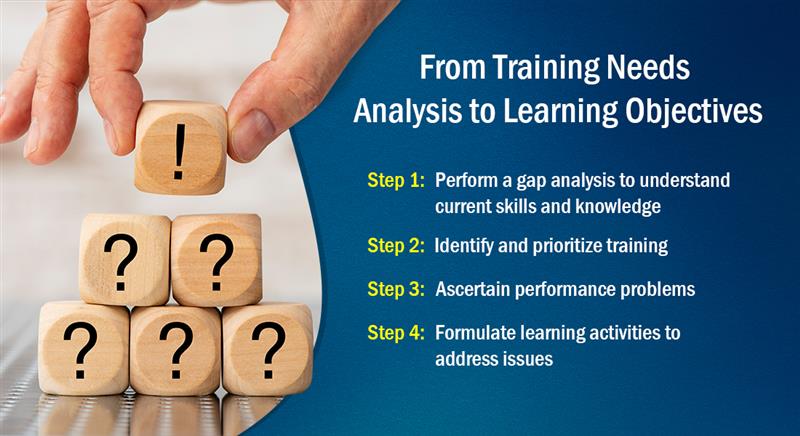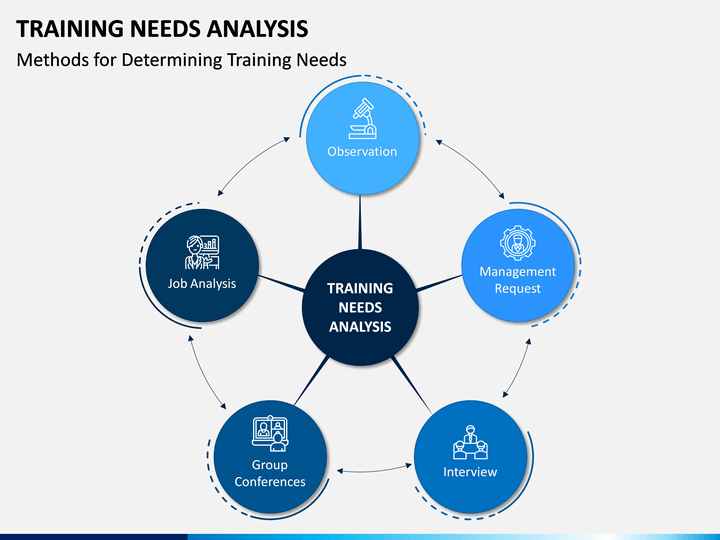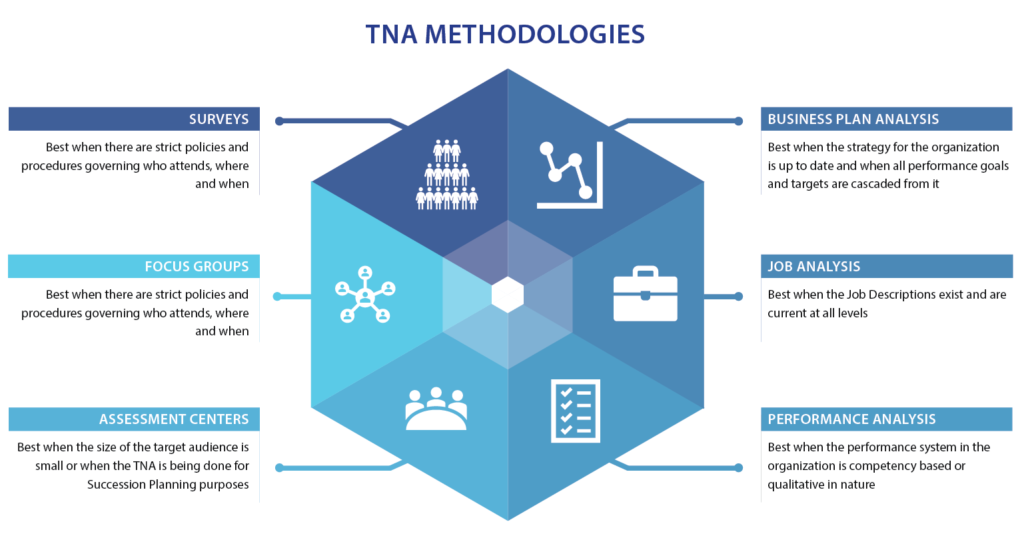
Meaning and Definition of TNA
Analysis of training needs (TNA) places greater emphasis on needs than demands. Its other name, “training needs Analysis,” describes it as a method used to determine the educational programmes or skills that need to be made available to the staff and management in order to improve their productivity and managerial abilities.
It is managers intriguing but less that they focus on their management abilities instead of technical components which are more effective in improving productivity and morale in order to overcome the suggested to problem experienced by managers in handling their staff.
The evaluation of training requirements makes it simple to decide whether training is necessary and, if so, what sort of training should be given to control the discrepancy between expected and actual performance.
“Need assessment may be described as a method for finding and prioritising gaps between existing and intended results,” claim Kaufman et al.
“Need assessment may be characterised as a way of determining the type and degree of performance problems and how they might be solved,” write Molenda, Pershing, and Reigeluth.
Allison Rossett states that “Training need assessment is the systematic effort that we undertake to obtain opinions and suggestions on performance issues or new systems and technology from a range of sources.”
Objectives of TNA
The identifying training needs assessment’s goals are as follows:
1) To identify an organization’s performance needs or requirements so that underperforming areas can receive the resources necessary for better functioning.
2) To increase staff effectiveness.
3) To create high-quality products and services
4) To achieve the organization’s aims and objectives.
5) To create a standard by which trainings would be assessed.
6) To identify any discrepancies between the employee’s skills and those that are necessary for him to operate efficiently.
7) To cut down on the time and money spent on the training programme.
8) To align training operations with the strategic strategy of the organisation.
9) To inspire the staff.
10) To determine the ideal working setting required for the training.
Levels of TNA

An evaluation of training requirements is done at the following three stages.
1.Organizational analysis: Goal-focused training is necessary at the organisational level. Strategic planning and corporate requirements. There are two sorts of environments in each organisation: the internal environment and the external environment. While the external environment consists of dangers and opportunities, the internal environment includes the organization’s strengths and weaknesses, organisational structure, policies, and processes.
The human resource department should be included in the strategic planning of the company in order to make this analysis successful inside the organisation. The KSA (Knowledge, Skills, and Abilities) of the employees should be taken into account while developing plans by the HR department.
2) Task Analysis: To get the best performance, the necessary details about a job are gathered. The task analysis provides KSAs and attitude. The task analyst gathers information on the employees’ degree of comprehension of the duties while emphasising the ones that have been assigned to them. Additionally, he gathers data on ongoing and upcoming work using TNA as the basis.
3) Individual Analysis: Also known as man analysis, individual analysis identifies which employee(s) requires training. This data may be acquired from a variety of sources, but it’s crucial to make sure that training can control the gap between an employee’s performance and the expected outcomes.
Even when they meet all employment requirements, some employees may be dissatisfied and perform poorly. Employees require performance management, not training, if they are unmotivated to complete a task for which they are qualified. The efforts made to teach the staff in such a situation would be ineffective and would just raise the expense of training.
The manager should be aware that poor performance isn’t necessarily the result of a lack of enthusiasm or inept abilities; it might also be the result of a breakdown in communication between the employee and the management.
The employee may not know what is expected of him since the management is unable to explain the task that needs to be done. Therefore, the management should explain the tasks to the staff rather than concentrating on training.
Methods of TNA

Several techniques are employed to gather data on employee performance. These are the techniques:
1) Observation: This strategy simply involves watching the workers as they go about their daily business in order to gauge how well they are performing. The full picture is shown by the tasks that employees do and how well they complete them. With this strategy, the observer who is closely monitoring the employee’s performance abstains from taking part in the activities the employee is engaged in.
2) Interviews: One of the most crucial instruments for determining the need for training is the interview. The same questions are posed to various sources during the interview process so that the information obtained may be assessed as either a single person’s perspective or a widely held opinion. Interviews assist the trainer in face-to-face engagement and performance evaluation of the workforce.
3) Questionnaires: In a questionnaire, questions are constructed with the employee’s perceptions of organisational communication, job characteristics, working conditions, compensation structure, promotion practises, etc. in mind. The skills of the personnel and the areas where they fall short may be analysed with the use of information from the questionnaire.
4) Analysis: Research must be done before a job description is written. When a job description is finalised, a thorough examination of the duties and obligations attached to the position is conducted. After doing a post-job analysis, it is simple for the trainer to create his training programme while taking into account the high expectations that the employer has for the employee.A job analysis consists of a job description.
5) Difficulty Analysis: Difficulty analysis identifies the jobs that cause the most difficulty for the employee so that appropriate training may be used to reduce this difficulty.
6. Problem Solving Conference: Employees often utilise the approach of scheduling problem-solving conferences on a regular basis. The gathering can be planned in conjunction with the launch of a new technology or product, the launch of a new strategy, or the beginning of a new training session. These discussions reveal training weaknesses that need to be focused on more.
7) Evaluation reviews: When performing the routine counselling performance interview, a worker should be asked about the training and responsibilities of his employees. These inquiries yield sincere responses and assist in identifying the actual needs and gaps necessary for a successful training need analysis.
8) Drive Pattern Identification: An employee’s degree of growth is determined by his level of motivation. It is possible to determine a worker’s training requirements and how to motivate him to pursue those goals if the elements that influence his behaviour are recognised.
9) Organizational Policy Analysis: Different organisational policies have an impact on the training that is provided to employees. The training reform or redesign of the training programme should thus take this policy framework into consideration. programmes so that the staff members may be well equipped. the regulations that call for adjustment,
TNA procedure

The actions that should be taken while doing a training needs analysis are as follows:
Step 1: Start Talking to Top Management: Making sure that senior management employees are visible from the start and involved is crucial. The analysis and any necessary discussions with managers, supervisors, or other staff members are authorised with their approval.
Step 2: Establish TNA Schedule and Goals: To save expenses, TNA should be implemented in a regulated, organised, and effective manner. To do this, TNA objectives must be made crystal clear before to implementation.
Step 3: Identifying the Information Source: The third stage is to identify the information source in order to establish the necessity for training as well as to identify the different information sources that can serve as input. There are several sources of information, including observation, interviews, debates, and surveys. In addition to these, background data and organisational statistics are less important sources.
Step 4: Construct Data Collection Procedures: The creation of data gathering techniques that are appropriate for an organisation comes after the sources of information have been identified. Depending on the organisation, a different data gathering strategy may be more appropriate. Therefore, it is crucial to choose the best approach that will deliver the needed information in the most efficient and current way.
Step 5: Engage in dialogue with top management: Engage in dialogue with top management. Scheduling is also necessary for the information-gathering step.
Check here for latest case studies and research book : https://kit.co/Anurooba/case-analysis-text-books
Step 6: Data Analysis and Training Needs Identification: It is the most significant since it is at this point that the information that has been gathered is correctly analysed, and as a result, the need for training is determined. Each training requirement must first be identified, and then it must be supported by evidence.
Step 7: Create Training Goals: There are several benefits to setting explicit training objectives, including the following:
1) It is obvious what needs to be accomplished from the training when the objectives are clearly explained.
2) By defining the training objectives, the intended outcome of the training is revealed.
2)The management will be more eager to impart the training if the training’s outcome is known.
Stage 8: Create a Training Plan: In this step, it is chosen whether to provide on-the-job or off-the-job training to address the identified needs. The development of the training plan is aided by the training objectives, supporting data, and the training required as a result of the recognised needs. The training plan can be turned into a training programme after receiving management clearance.
Step 9: Creation of TNA Report: To a certain extent, the analysis’s veracity is By this point, the organization’s members would have expended a considerable amount of time providing information and discussing the analysis. As a result, being well-prepared for the meeting becomes crucial. The analytical report would be interesting to the management to review and discuss.
TNA’s significance

The following highlights the significance of training needs analysis:
1) TNA identifies training and other similar advancements as necessary for professional growth.
2) By ensuring that only those trainings are done with participants and would get the desired results, TNA prevents time being wasted on pointless trainings.
3) TNA establishes a criteria for KSAs that workers must meet in order to apply for transfers, promotions, and training programmes.
4) When a result of TNA, employees feel more united as they come together to discuss the need for training for specific job positions.
5) Supervisors may use TNA to acquire an overview of the abilities, knowledge, and skills required for personnel to do their jobs efficiently.
6) With the use of TNA, management programmes may offer training and development the attention it deserves by carrying out professional and technical training.
7) TNA helps to lessen the difference in expectations and needs that occurs between personnel receiving training and their bosses. When both employees and their supervisors are included in the survey before the training, it adds an added layer of assistance.
TNA’s restrictions

The following are some drawbacks of training needs analysis:
1) It must employ a qualified individual and utilise his time effectively.
2) Because TNA is deployed at all levels of the company, it takes a long time to implement.
3) Due to senior management’s lack of backing, dedication, and involvement in TNA, there is a chance that recognising fictitious needs.
4) If TNA is not adequately carried out, the organisation is accused of squandering and overusing cash on pointless activities.
5) Employees may reject TNA if they believe it would draw attention to their shortcomings.
6) Managers may overlook the value of TNA and believe that training is a superior alternative.
Other Related Topics: